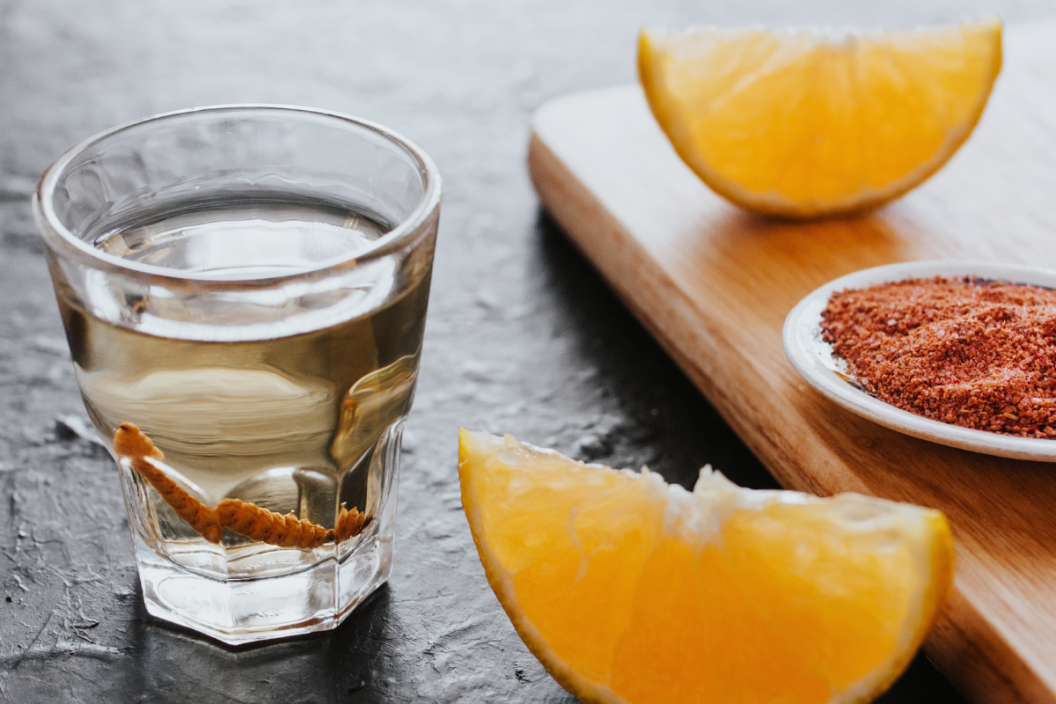I recently discovered mezcal, specifically mezcalitas. These delicious cocktails are margaritas, but made with mezcal, giving them a smokey, complex flavor. I was immediately converted to the mezcal club, which left me wondering about this unique liquor that had escaped my attention until now. One of my biggest questions was, what's the deal with the worm at the bottom of a mezcal bottle?
What is Mezcal, Anyway?
https://www.instagram.com/p/CRjsRvns1nG/
Although often lumped in with tequila, tequila is actually a type of mezcal, not the other way around. This liquor is made in Mexico, from the heart of the agave plant. To make it, one roasts the heart and mashes it up, then ferments it in a barrel, where it gains its distinctively smoky taste. Mezcal can be made of any agave plant, while a bottle of tequila can only be created from blue agave.
Even though these two Mexican alcohols come from the same plant, they originate in different parts of Mexico. Mezcal is from the southern state of Oaxaca, while tequila is from the city of Tequila in the northern state of Jalisco.
Along with having a different origin and flavor than tequila, mezcal has another big distinction- the infamous mezcal worm at the bottom of the bottle. This worm, called the gusano in Spanish, has a reputation for being an aphrodisiac and hallucinogen.
The Mezcal Worm
https://www.instagram.com/p/CGgeZHvJaM3/
There are few different varieties of the famous mezcal worm, also called the agave worm. One is the red worm, or gusano rojo, which is the more desirable kind. There's also the chinicuil or maguey worm, called the gusano de maguey in Spanish, which is the moth larvae of the Comadia redtenbacheri.
Another kind is the larva of the agave snout weevil, an insect that infests agave plants. This variety is considered a delicacy, and is roasted and eaten throughout southeastern Mexico. Interestingly, one of the traditions in a Mexican bachelorette party is for the maid of honor to eat the mezcal worm, which has a similar symbolism to throwing the bouquet.
The First Mezcal Worm
https://www.instagram.com/p/CQwu12KrmkV/
This larvae was first added to a bottle of mezcal in the 1940s or 50's, and its origin is up for debate. It's purported that a man named Jacobo Lozano Páez, who worked at a bottling plant, was first to come up with the idea. Some say that the worm is simply a marketing ploy, designed to attract tourists and give the smoky liquor an exotic twist.
Others say that the mezcal worm is more than a marketing gimmick, and is actually added to bottles of mezcal to demonstrate their purity. As the Beverage Testing Institute explains, "one story is that... if the worm remains intact in the bottle, the percentage of alcohol in the spirit is high enough to preserve the pickled worm."
The first company to add the worm to a mezcal bottle was Nacional Vinicola, now called Gusano Rojo, which means red worm in Spanish. Soon, other mezcal makers followed suit, such as Patron and Monte Alban Mezcal.
Although there's no evidence of the supposed aphrodisiac qualities of the mezcal worm in humans, it has been shown that it works as an aphrodisiac for some mammal and insect species. As for the hallucinogenic properties, that rumor might be a result of the amount of intoxication that would come with getting to the bottom of a mezcal bottle.
Mmm, Mezcalitas!
Whether reading about the mezcal worm makes you intrigued or disgusted, I can attest to the tastiness of this Mexican liquor, although I haven't yet tried the famous worm. Here's a recipe for a smokey, flavorful mezcalita to try for yourself!




